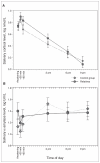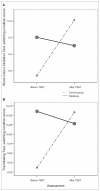Dysregulation of the sympathetic nervous system, hypothalamic-pituitary-adrenal axis and executive function in individuals at risk for suicide
- PMID: 20731961
- PMCID: PMC2964370
- DOI: 10.1503/jpn.090121
Dysregulation of the sympathetic nervous system, hypothalamic-pituitary-adrenal axis and executive function in individuals at risk for suicide
Abstract
Background: Suicidal behaviour aggregates in families, and the hypothalamic-pituitary-adrenal (HPA) axis and noradrenergic dysregulation may play a role in suicide risk. It is unclear whether stress dysregulation is a heritable trait of suicide or how it might increase risk. We investigated stress reactivity of the autonomic nervous system and the HPA axis in suicide predisposition and characterized the effect of this dysregulation on neuropsychologic function.
Methods: In this family-based study of first-degree relatives (n = 14) of suicide completers and matched controls with no family or personal history of suicidal behaviour (n = 14), participants underwent the Trier Social Stress Test (TSST). We used salivary α-amylase and cortisol levels to characterize stress reactivity and diurnal variation. We administered a series of neuropsychologic and executive function tests before and after the TSST.
Results: Despite normal diurnal variation, relatives of suicide completers exhibited blunted cortisol and α-amylase TSST reactivity. Although there were no baseline differences in conceptual reasoning, sustained attention or executive function, the relatives of suicide completers did not improve on measures of inhibition upon repeated testing after TSST. Secondary analyses suggested that these effects were related to suicide vulnerability independent of major depression.
Limitations: The sample size was small, and the design prevents us from disentangling our findings from the possible traumatic consequences of losing a relative by suicide.
Conclusions: Blunted stress response may be a trait of suicide risk, and impairment of stress-induced executive function may contribute to suicide vulnerability.
Figures



Similar articles
-
Cortisol responses to psychosocial stress predict depression trajectories: social-evaluative threat and prior depressive episodes as moderators.J Affect Disord. 2012 Dec 20;143(1-3):223-30. doi: 10.1016/j.jad.2012.05.059. Epub 2012 Aug 1. J Affect Disord. 2012. PMID: 22858210 Free PMC article. Clinical Trial.
-
Hypothalamic-pituitary-adrenal axis dysregulation in depressed adolescents with non-suicidal self-injury.Psychoneuroendocrinology. 2019 Apr;102:216-224. doi: 10.1016/j.psyneuen.2018.11.004. Epub 2018 Nov 14. Psychoneuroendocrinology. 2019. PMID: 30590339
-
Altered psychobiological responsiveness in women with irritable bowel syndrome.Psychosom Med. 2012 Feb-Mar;74(2):221-31. doi: 10.1097/PSY.0b013e318244fb82. Epub 2012 Jan 27. Psychosom Med. 2012. PMID: 22286854
-
Neuroendocrine coordination and youth behavior problems: A review of studies assessing sympathetic nervous system and hypothalamic-pituitary adrenal axis activity using salivary alpha amylase and salivary cortisol.Horm Behav. 2020 Jun;122:104750. doi: 10.1016/j.yhbeh.2020.104750. Epub 2020 Apr 21. Horm Behav. 2020. PMID: 32302595 Review.
-
[Stress and psychotic transition: A literature review].Encephale. 2016 Aug;42(4):367-73. doi: 10.1016/j.encep.2015.10.001. Epub 2016 May 6. Encephale. 2016. PMID: 27161263 Review. French.
Cited by
-
Reduced frontal-subcortical white matter connectivity in association with suicidal ideation in major depressive disorder.Transl Psychiatry. 2016 Jun 7;6(6):e835. doi: 10.1038/tp.2016.110. Transl Psychiatry. 2016. PMID: 27271861 Free PMC article.
-
Associations between the neuron-specific glucocorticoid receptor (NR3C1) Bcl-1 polymorphisms and suicide in cancer patients within the first year of diagnosis.Behav Brain Funct. 2016 Jul 11;12(1):22. doi: 10.1186/s12993-016-0104-1. Behav Brain Funct. 2016. PMID: 27401254 Free PMC article.
-
Novel Treatment Targets Based on Insights in the Etiology of Depression: Role of IL-6 Trans-Signaling and Stress-Induced Elevation of Glutamate and ATP.Pharmaceuticals (Basel). 2019 Jul 29;12(3):113. doi: 10.3390/ph12030113. Pharmaceuticals (Basel). 2019. PMID: 31362361 Free PMC article. Review.
-
Cognitive Performance in First-Degree Relatives of Individuals With vs Without Major Depressive Disorder: A Meta-analysis.JAMA Psychiatry. 2019 Mar 1;76(3):297-305. doi: 10.1001/jamapsychiatry.2018.3672. JAMA Psychiatry. 2019. PMID: 30586133 Free PMC article.
-
Deterministic learning and attempted suicide among older depressed individuals: cognitive assessment using the Wisconsin Card Sorting Task.J Psychiatr Res. 2012 Feb;46(2):226-32. doi: 10.1016/j.jpsychires.2011.10.001. Epub 2011 Oct 22. J Psychiatr Res. 2012. PMID: 22024486 Free PMC article.
References
-
- World Health Organization. The world health report 2000: health systems: improving performance. Geneva: The Organization; 2000.
-
- Barraclough B, Bunch J, Nelson B, et al. A hundred cases of suicide: clinical aspects. Br J Psychiatry. 1974;125:355–73. - PubMed
-
- Gould MS, Fisher P, Parides M, et al. Psychosocial risk factors of child and adolescent completed suicide. Arch Gen Psychiatry. 1996;53:1155–62. - PubMed
-
- Brent DA, Bridge J, Johnson BA, et al. Suicidal behavior runs in families. A controlled family study of adolescent suicide victims. Arch Gen Psychiatry. 1996;53:1145–52. - PubMed
-
- Brent DA, Oquendo M, Birmaher B, et al. Familial pathways to early-onset suicide attempt: risk for suicidal behavior in offspring of mood-disordered suicide attempters. Arch Gen Psychiatry. 2002;59:801–7. - PubMed
Publication types
MeSH terms
Substances
Grants and funding
LinkOut - more resources
Full Text Sources
Other Literature Sources
Medical
